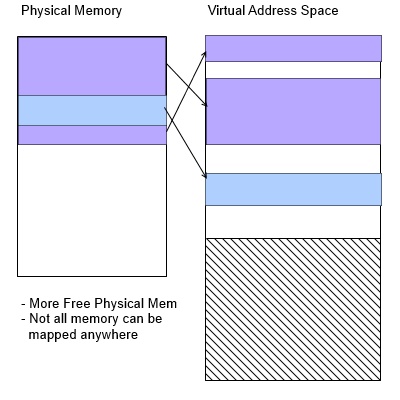Copyright (c) Hyperion Entertainment and contributors.
Exec Extended Memory: Difference between revisions
Steven Solie (talk | contribs) Created page with "= Overview = AmigaOS is a 32 bit OS. There is little we can change about it. The size of an address pointer is intrinsically entangled into the API, and getting rid of this l..." |
Steven Solie (talk | contribs) |
||
| Line 10: | Line 10: | ||
A virtual address, on the other hand, is what the CPU and hence the application program sees. They might be the same, but as a general rule, they are different. Virtual addresses are given on the fly, but there is a rule that every memory cell must have a unique virtual address, because all references to that cell are stored as the virtual address the application sees. |
A virtual address, on the other hand, is what the CPU and hence the application program sees. They might be the same, but as a general rule, they are different. Virtual addresses are given on the fly, but there is a rule that every memory cell must have a unique virtual address, because all references to that cell are stored as the virtual address the application sees. |
||
[[File:fig1-ext-mem.jpg|frame|center|Physical Memory vs Virtual Address Space]] |
|||
Modern systems like the X1000 or upcoming models can take more than 4 gigabytes of memory, but so far, the extra memory will never be used. Even in a 4 gigabyte system, there is memory that will never be touched because there is just no free address; and unfortunately, every byte needs to have its own virtual address, and no two bytes can have the same. |
Modern systems like the X1000 or upcoming models can take more than 4 gigabytes of memory, but so far, the extra memory will never be used. Even in a 4 gigabyte system, there is memory that will never be touched because there is just no free address; and unfortunately, every byte needs to have its own virtual address, and no two bytes can have the same. |
||
Revision as of 02:11, 2 September 2015
Overview
AmigaOS is a 32 bit OS. There is little we can change about it. The size of an address pointer is intrinsically entangled into the API, and getting rid of this legacy is, for the most part, a matter of replacing all of the API with a new one. Every time a programmer writes something like “sizeof(struct Message)”, the 32 bit nature is fused into his code.
This has some repercussions that cannot be easily ignored. It means that our address space is inherently limited to 32 bits (meaning 4 gigabytes). In reality this space is even smaller than that. PCI space, the kernel, memory buffers, and other memory areas take up a large chunk of the already limited address space, leaving roughly 2 gigabytes for the applications running on the machine – 2 gigs which also are shared between all of the programs running.
Physical Vs. Virtual
A physical address of a memory block is implicitly defined by its position within the memory chips, and the order in which the modules are inserted into the mainboard’s memory slots. They start at zero and go up to a specific maximum.
A virtual address, on the other hand, is what the CPU and hence the application program sees. They might be the same, but as a general rule, they are different. Virtual addresses are given on the fly, but there is a rule that every memory cell must have a unique virtual address, because all references to that cell are stored as the virtual address the application sees.

Modern systems like the X1000 or upcoming models can take more than 4 gigabytes of memory, but so far, the extra memory will never be used. Even in a 4 gigabyte system, there is memory that will never be touched because there is just no free address; and unfortunately, every byte needs to have its own virtual address, and no two bytes can have the same.
Unless…